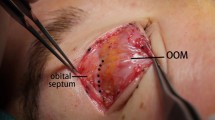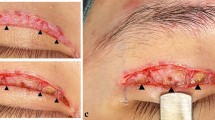Abstract
Background
Incisional double-eyelid blepharoplasty is widely applied because of its extensive indications and robust results. The orbicularis-levator fixation method is an incisional approach that provides stronger adhesion than traditional techniques. However, there remains the risk of postoperative relapse or suture spitting out.
Methods
The authors introduced a modified technique for supratarsal crease formation. When necessary soft tissue removal was completed, the orbicularis oculi muscle was anchored on the tarsus. Then the muscle edges near canthus were reattached to prevent muscle retraction. For skin closure, the skin-pretarsal fascia-skin maneuver was adopted to enhance cicatricial adhesion.
Results
Six hundred and fifty-nine patients underwent double eyelidplasty by the same surgeon using this modified technique. Patients were followed up from 2 to 38 months, with a mean period of 15 months. Short-term complications included mild edema, bruising or reddish change of the upper eyelid, yet all gradually relieved in 6–8 weeks. Fourteen cases of palpebral fold asymmetry and nine cases of unsatisfactory fold formation near the inner canthus were encountered, and all the defects had been well improved by revision surgeries. Ninety-five percent of the patients were satisfied with the long-term outcomes, which showed as natural and well-defined palpebral folds without scar hypertrophy, suture spitting out or crease depression. Besides, no supratarsal crease drooping or disappearing was observed 3 years postoperatively.
Conclusions
The authors introduced an orbicularis-tarsus fixation method for upper eyelid blepharoplasty. It is a reliable technique that enables high feasibility and long-lasting result, and with lower risk of suture spitting out.
Level of Evidence IV
This journal requires that authors assign a level of evidence to each article. For a full description of these Evidence-Based Medicine ratings, please refer to the Table of Contents or the online Instructions to Authors www.springer.com/00266.














Similar content being viewed by others
References
Hwang HS, Spiegel JH (2014) The effect of “single” vs “double” eyelids on the perceived attractiveness of Chinese women. Aesthet Surg J Am Soc Aesthet Plast Surg 34(3):374–382
Zide BM (2006) Surgical anatomy around the orbit: the system of zone, 2nd edn. Lippincott Williams & Wilkins, Philadelphia
Mikamo M (1997) Mikamo’s double-eyelid operation: the advent of Japanese aesthetic surgery. Plast Reconstr Surg 99:662–667
Song RY, Song YG (1985) Double eyelid operations. Aesthet Plast Surg 9:173–180
Bang YH (1991) The double-eyelid operation without supratarsal fixation. Plast Reconstr Surg 88:12–17
McCurdy JA Jr (2002) Upper blepharoplasty in the Asian patient: the “double eyelid” operation. Facial Plast Surg Clin N Am 10:351–368
Choi Y, Eo S (2010) A new crease fixation technique for double eyelidplasty using mini-flaps derived from pretarsal levator tissues. Plast Reconstr Surg 126(3):1048–1057
Moon KC, Yoon ES, Lee JM (2013) Modified double-eyelid blepharoplasty using the single-knot continuous buried non-incisional technique. Arch Plast Surg 40(4):409–413
Li L, Ni B, Pan S, Lin Y (2014) Creating natural double eyelids with continuous buried suture and mini-incision technique using subcutaneous absorbable suture for patients with puffy eyelids. JAMA Facial Plast Surg 16(3):188–192
Park JI (1999) Orbicularis-levator fixation in double-eyelid operation. Arch Facial Plast Surg 1(2):90–95
Park JI, Park MS (2007) Double-eyelid operation: orbicularis oculi-levator aponeurosis fixation technique. Facial Plast Surg Clin N Am 15(3):315–326
Nguyen MQ, Hsu PW, Dinh TA (2009) Asian blepharoplasty. Semin Plast Surg 23(3):185–197
Pottier F, El-Shazly NZ, El-Shazly AE (2008) Aging of orbicularis oculi: anatomophysiologic consideration in upper blepharoplasty. Arch Facial Plast Surg 10(5):346–349
Lee H, Park M, Lee J et al (2012) Histopathologic findings of the orbicularis oculi in upper eyelid aging. Arch Facial Plast Surg 14(4):253–257
Lee JW, Baker SR (2013) Esthetic enhancements in upper blepharoplasty. Clin Plast Surg 40(1):139–146
Gradinger GP (1988) Cosmetic upper blepharoplasty. Clin Plast Surg 15(2):289–297
Rohrich RJ, Coberly DM, Fagien S et al (2004) Current concepts in aesthetic upper blepharoplasty. Plast Reconstr Surg 113(3):32e–42e
Furnas DW (1981) The orbicularis oculi muscle. Management in blepharoplasty. Clin Plast Surg 8(4):687–715
Presti P, Yalamanchili H, Honrado CP (2006) Rejuvenation of the aging upper third of the face. Facial Plast Surg 22(2):91–96
Wu LW, Ye Z, Xu Y et al (2015) Orbicularis-levator-tarsus composite suture technique in double-eyelid operation. J Plast Reconstr Aesthet Surg 68(8):1079–1084
Funding
This work is supported by Teaching Reform Project of Peking Union Medical College (10023201504024).
Author information
Authors and Affiliations
Corresponding author
Ethics declarations
Conflict of interest
The authors have no financial or conflicts of interest to disclose.
Electronic supplementary material
Below is the link to the electronic supplementary material.
Rights and permissions
About this article
Cite this article
Sun, W., Wang, Y., Song, T. et al. Orbicularis-Tarsus Fixation Approach in Double-Eyelid Blepharoplasty: A Modification of Park’s Technique. Aesth Plast Surg 42, 1582–1590 (2018). https://doi.org/10.1007/s00266-018-1218-7
Received:
Accepted:
Published:
Issue Date:
DOI: https://doi.org/10.1007/s00266-018-1218-7




